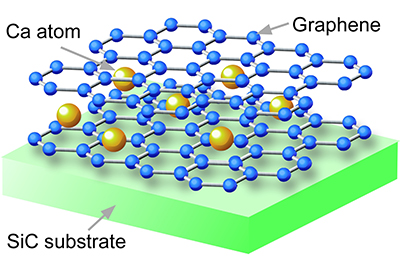Graphene becomes superconductive – Electrons with "no mass" flow with "no resistance"

Figure 1: Crystal structure of Ca-intercalated bilayer graphene fabricated on SiC substrate. Insertion of Ca atoms between two graphene layers causes the superconductivity. Copyright : Tohoku University
Graphene is a single-atomic carbon sheet with a hexagonal honeycomb network (Fig. 1). Electrons in graphene take a special electronic state called Dirac-cone where they behave as if they have no mass. This allows them to flow at very high speed, giving graphene a very high level of electrical conductivity.
This is significant because electrons with no mass flowing with no resistance in graphene could lead to the realization of an ultimately high-speed nano electronic device.
The collaborative team of Tohoku University and the University of Tokyo has developed a method to grow high-quality graphene on a silicon carbide (SiC) crystal by controlling the number of graphene sheets. The team fabricated bilayer graphene with this method and then inserted calcium (Ca) atoms between the two graphene layers like a sandwich (Fig. 1).
They measured the electrical conductivity with the micro four-point probe method and found that the electrical resistivity rapidly drops at around 4 K (-269 °C), indicative of an emergence of superconductivity (Fig. 2).
The team also found that neither genuine bilayer graphene nor lithium-intercalated bilayer graphene shows superconductivity, indicating that the superconductivity is driven by the electron transfer from Ca atoms to graphene sheets.
The success in fabricating superconducting graphene is expected to greatly impact both the basic and applied researches of graphene.
It is currently not clear what phenomenon takes place when the Dirac electrons with no mass become superconductive with no resistance. But based on the latest study results, further experimental and theoretical investigations would help to unravel the properties of superconducting graphene.
The superconducting transition temperature (Tc) observed in this study on Ca-intercalated bilayer graphene is still low (4 K). This prompts further studies into ways to increase Tc, for example, by replacing Ca with other metals and alloys, or changing the number of graphene sheets.
From the application point of view, the latest results pave the way for the further development of ultrahigh-speed superconducting nano devices such as a quantum computing device, which utilizes superconducting graphene in its integrated circuit.
Publication Details:
Authors: Satoru Ichinokura, Katsuaki Sugawara, Akari Takayama, Takashi Takahashi and Shuji Hasegawa
Title: Superconducting Calcium-Intercalated Bilayer Graphene
Journal: ACS Nano (2016)
DOI: 10.1021/acsnano.5b07848
Contact:
Takashi Takahashi
Advanced Institute for Materials Research, Tohoku University
Tel: +81-22-217-4816
Fax: +81-22-217-4818
Email: t.takahashiarpes.phys.tohoku.ac.jp
Associated links
Original article from Tohoku University
Media Contact
All latest news from the category: Materials Sciences
Materials management deals with the research, development, manufacturing and processing of raw and industrial materials. Key aspects here are biological and medical issues, which play an increasingly important role in this field.
innovations-report offers in-depth articles related to the development and application of materials and the structure and properties of new materials.
Newest articles

Combatting disruptive ‘noise’ in quantum communication
In a significant milestone for quantum communication technology, an experiment has demonstrated how networks can be leveraged to combat disruptive ‘noise’ in quantum communications. The international effort led by researchers…

Stretchable quantum dot display
Intrinsically stretchable quantum dot-based light-emitting diodes achieved record-breaking performance. A team of South Korean scientists led by Professor KIM Dae-Hyeong of the Center for Nanoparticle Research within the Institute for…

Internet can achieve quantum speed with light saved as sound
Researchers at the University of Copenhagen’s Niels Bohr Institute have developed a new way to create quantum memory: A small drum can store data sent with light in its sonic…





















